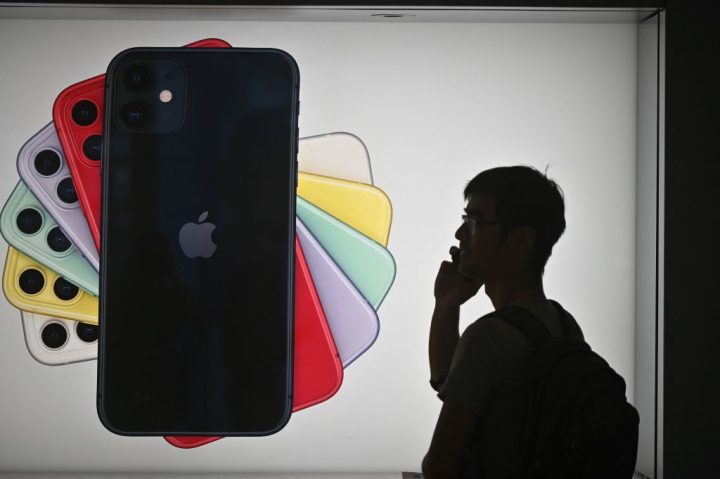A call from my younger son’s secondary school was not what I was expecting at 11.30 a.m., but as soon as I heard the secretary speak I knew what had happened to him.
He’d just got himself a pair of Apple AirPods and was keen to use them – why wouldn’t he be? As he stepped off the bus, with his new wireless earphones in place, he was followed up the road to the school by two boys.
A strategy which targets crime gangs is more likely to yield results than a drive to investigate every phone theft
Suddenly, from behind, they made their move, grabbing him in a headlock. It took only a few seconds but enough time for them to get what they wanted: the AirPods, of course – and his smartphone.
What happened to my son, who was 15 at the time, is par for the course among teenagers in London. Although the circumstances are not always as violent as that, I suspect most young people will have their phone nicked at one time or another. Figures obtained by the BBC show that in 2022 the Metropolitan Police received 91,000 reports of stolen phones from members of the public.
The number has barely budged over the past ten years and equates to one phone reported stolen every six minutes. And although the cases undoubtedly include false claims, where people seek a crime reference number for phones that have been lost, broken or flushed down the toilet, the true figure is probably higher. According to separate data from the Office for National Statistics (ONS), only around 63 per cent of thefts are reported to and recorded by police in England and Wales.
Phone theft is not a new phenomenon. In 1995, an information leaflet circulated to MPs by the Parliamentary Office of Science and Technology said mobiles were at the ‘centre of a rapidly growing crime wave’ with around 16,000 devices stolen across the UK every month. The cost of mobile phone crime was estimated at the time to be around £200 million each year.
Even in the mid-90s, with only 3 million phones in circulation in the country compared to 72 million mobile connections now, the authorities were having difficulty containing the problem. ‘The rapid growth in mobile phone crime initially took the industry by surprise and ever since it has been struggling to protect itself, with mixed results,’ the document says. ‘As soon as one weak point is dealt with, others open up to the extent that some in the industry see themselves in a continuous “guerrilla war” with the criminal community.’
Back then, the telecommunications industry was seen as key to tackling mobile phone crime through tighter regulations around the sale and use of handsets and improved security features. The police, in that paper at least, were not seen as the main answer to the problem. The sheer volume of cases, even 30 years ago, meant that alternatives to arrest and prosecution were required.
Changing patterns of car crime demonstrate that it is possible to bear down on a particular type of offending by designing it out rather than relying on the criminal justice route. In 1995, almost 500,000 vehicles were stolen, according to the ONS Crime Survey of England and Wales (including cases not reported to police). Last year, that had dropped to 72,000. The number of thefts from vehicles, such as car stereos, also plummeted from 2.5 million to an estimated 519,000. Electronic immobilisers, deadlocking systems and alarms are the main enhancements that are widely credited to have kept criminals at bay.
Mobile phone security has improved as well. Features that allow users to trace their handset, lock applications and wipe data remotely have made the thief’s job harder. As a result of these measures, they may not be able to re-set the device and sell it on, or access the personal information which enables them to spend money.
But there is still, clearly, a lucrative global market for stolen phones – particularly for spare parts. One man who had his £1,000 iPhone 14 Pro stolen in London reportedly tracked it down to a street in Shenzhen, China, 6,000 miles away, where he suspected it was about to be cannibalised. With a bit of expertise, elements from different devices can be assembled in such a way that a phone looks as though it’s a new or nearly new model. It suggests that although most phone thefts are opportunistic, in some cases organised criminal networks are involved, shipping handsets overseas where they can be broken down, reconstituted and sold on.
A strategy which targets crime gangs, therefore, is more likely to yield results than a drive to investigate every phone theft. In London, certainly, the latter just isn’t possible. Unless violence is used, or there’s a clear pattern of offending, for example by using mopeds to target people, the police response will be minimal. The Met’s Basic Command Units, where the officers responsible for dealing with such cases are based, were said to be ‘creaking at the seams’ by Baroness Casey in her recent review of the force. Mobile phone theft is simply not a priority, with only 2 per cent of phones recovered.
My son never got his phone back either. We managed to trace someone who had used it to order items online and supplied that information to the police. The ‘safer schools’ officer who was handling the case was helpful and diligent; he pursued it for a while…before being diverted onto more pressing matters.
It’s sad to say, but we can’t rely on the police to solve this problem – it’s down to us. Keep your phone secure and take extra care when you put your AirPods in.






Comments